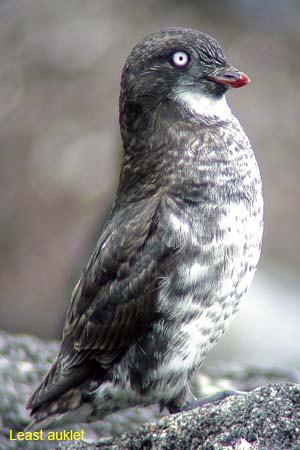Finding homes for homeless auklets

Thursday, April 22 2010
Unalaska, AK – Hundreds of thousands least and crested auklets used to nest on Kasatochi Island. But in August of 2008, the island's volcano erupted and covered the entire place in ash and leaving all of the birds homeless. It was one of only seven major colony sites for the birds in the Aleutian chain. Now they need new places to go to breed.
Bird biologist Ian Jones said their options are limited. They could nest on nearby Kiska Island, which already has a large colony living on the lava flows from the 1970s. But it also has rats.
"The analogy I've used is it's sort of like the hotel where people check in but they don't check out because they're getting murdered by this evil force," Jones said.
Norway rats infested Kiska during World War II. Least and crested auklets have continued to nest there since that time, but during some years their breeding efforts are fruitless. Rats devour their eggs and young. Jones and his students have been monitoring the birds on Kiska for nine years now. He said during two of those years the rat populations swelled and they seriously impaired the auklet reproduction. Jones and others are trying to figure out how this will affect the bird populations in the long term and how it will affect the individuals that relocated from Kasatochi.
"Essentially they have no chance of reproducing on Kasatochi and quite likely they have got to find a new island to nest on. And the scary thought is that it might be Kiska that they go to. Which is the conservation equivalent of a black hole. They get sucked into there and the experience predation by rats."
Conservationists could try to eradicate rats from Kiska, as is being done on Rat Island, but Kiska is 20 miles long - much larger than any other island that has ever had a rat eradication project on it.
Jones said another option to help the auklets would be to use giant water hoses to blast the ash off of Kasatochi and give the birds back their nesting sites in the rock crevasses, but scientists have decided against that.
"This is going to sound a bit esoteric, but the idea is that when a volcanic eruption occurs it's a very unusual event and it could provide really interesting opportunities for research on succession and recovery of a volcanic island and biogeography to see how life comes back onto the island. Because the ash eruption basically eliminated all life on the island because of the heat of the ash," Jones explained.
Another option is to find the birds homes on other nearby islands. Some of the islands do have colonies on old lava flows, but many of the nesting areas are overgrown with grasses and other plants. The bird droppings help peat and plants quickly cover the areas.
"So one other possibility for auklets, that we're actually doing some experiments on, is to see if you can remove the peat and vegetation overgrowth manually from the piles of rocks that the birds nest in, and, thus, provide more places for them to nest."
Jones and his students began an experiment last summer and will return this summer to see if more birds are using the newly cleared areas. If they are, it could be a less costly conservation alternative to help the auklet populations.
Other experiments on auklets in the Aleutians this summer will focus on the tangerine-like scent emitted by crested auklets. Like the birds' crests, it was once thought that the scent served to attract mates. A new theory suggests that the scent might also be an insecticide that repels ticks.
Scientists have been monitoring auklet colonies and marked individuals in the Aleutians for decades.



